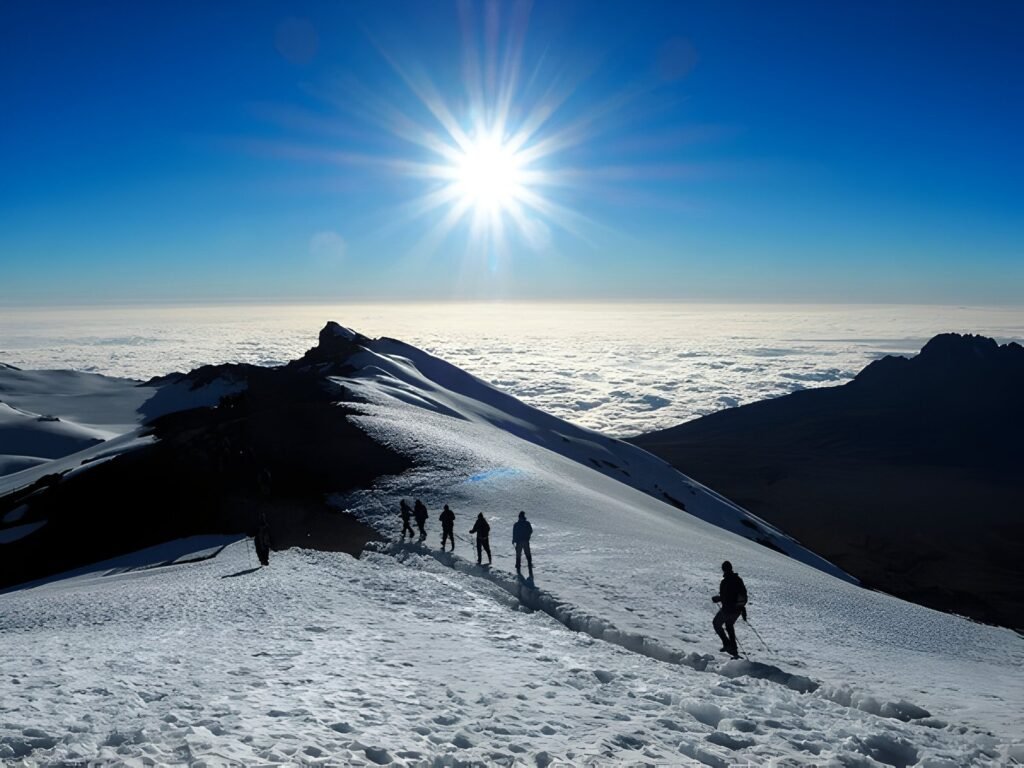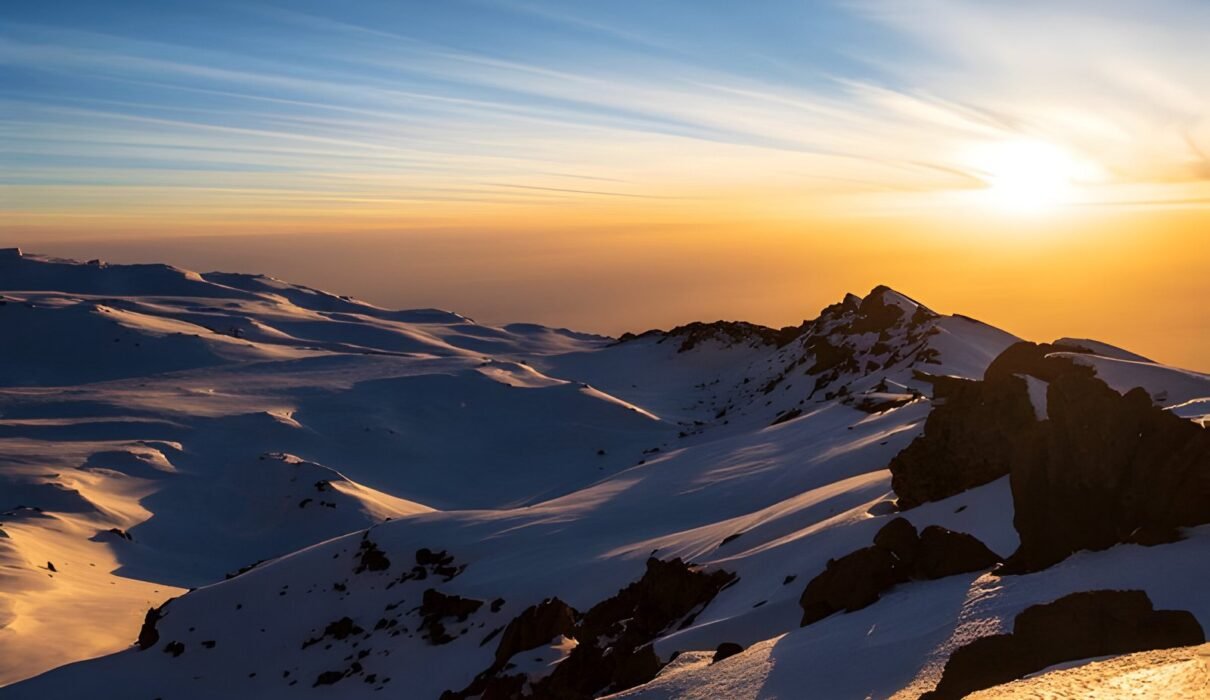Climbing Mount Kilimanjaro is a unique experience, not just because of its towering height of 5,895 meters (19,341 feet), but also due to the extreme variations in temperature that climbers face. As you ascend through five distinct climate zones, you’ll experience everything from tropical warmth to freezing, arctic conditions at the summit. Understanding Kilimanjaro’s temperature changes and preparing accordingly is crucial for a successful and safe climb.
This guide breaks down the different climate zones on Kilimanjaro and the temperature fluctuations you can expect in each one, helping you pack the right gear and clothing for every stage of your journey.

1. Tropical Rainforest Zone (800 – 3,000 meters)
Average Temperature: 20°C to 25°C (68°F to 77°F)
The base of Kilimanjaro is covered in dense tropical rainforest, with warm and humid conditions. The temperature in this zone remains relatively stable, with warm days and cooler nights. Due to the high humidity, you’ll likely encounter some rain, especially during the wet season (March to May and November).
What to Wear:
- Lightweight, moisture-wicking clothing: Keep cool and dry while hiking through the humid rainforest.
- Waterproof jacket and pants: The rainforest zone is prone to rain, so it’s important to stay dry.
Learn more about Kilimanjaro’s rainforest climate with Kilimanjaro Climb Specialist
2. Heath and Moorland Zone (3,000 – 4,000 meters)
Average Temperature: 5°C to 15°C (41°F to 59°F)
As you ascend into the heath and moorland zone, the temperature starts to drop significantly. The landscape transitions to shrubland, with large open spaces and fewer trees. During the day, temperatures can still be quite warm, but nights become cooler, sometimes dipping close to freezing.
What to Wear:
- Layered clothing: Use base layers that you can easily add or remove as the temperature fluctuates between day and night.
- Sun protection: The sun can be intense at higher altitudes, so wear a wide-brimmed hat and apply sunscreen.
Prepare for Kilimanjaro’s changing climate with Eddy Tours Safaris
3. Alpine Desert Zone (4,000 – 5,000 meters)
Average Temperature: -5°C to 10°C (23°F to 50°F)
The alpine desert zone is a barren, rocky environment with stark temperature extremes. Daytime temperatures can still reach comfortable levels, but at night, the mercury can plummet below freezing. The air becomes much drier, and the lack of vegetation makes the landscape appear almost lunar.
What to Wear:
- Insulated jacket: Prepare for cold nights by layering up with an insulated jacket.
- Thermal base layers: As temperatures drop at night, thermal clothing will help keep you warm.
- Lip balm and moisturizer: The dry air can cause chapped lips and dry skin, so pack these essentials.
Discover tips for Kilimanjaro’s alpine zone at Kilimanjaro Climb Specialist
4. Arctic Summit Zone (Above 5,000 meters)
Average Temperature: -7°C to -29°C (19°F to -20°F)
At the summit of Kilimanjaro, you’ll face extreme arctic conditions. The temperatures at night can plummet to as low as -20°C (-4°F), especially on the final summit push. During the day, the sun’s reflection off the glaciers can make it feel warmer, but the air remains freezing.
What to Wear:
- Down jacket: A high-quality down jacket is essential for keeping warm in the freezing summit zone.
- Waterproof gloves and thermal socks: Protect your extremities from the cold with insulated gloves and thick, thermal socks.
- Balaclava or face mask: The wind at the summit can be brutal, so a face mask or balaclava will help protect your skin from frostbite.
Learn how to prepare for Kilimanjaro’s summit temperatures
5. Temperature Variations by Season
Mount Kilimanjaro’s temperature is influenced by the time of year. While the mountain can be climbed year-round, certain months offer more favorable conditions depending on your preferences.
Dry Season (June to October and January to February):
- Best time to climb: The weather is more stable, with clear skies and less rain.
- Colder temperatures: The nights are generally colder during the dry season, especially at higher altitudes.
Wet Season (March to May and November):
- More rainfall: The rainforest zone experiences heavy rains, making trails slippery and increasing the risk of altitude sickness due to changing atmospheric conditions.
- Warmer nights: Despite the rain, nights tend to be warmer during the wet season, though higher altitudes still remain cold.
Plan your Kilimanjaro climb in the dry season with Kilimanjaro Climb Specialist
6. Preparing for Kilimanjaro’s Temperature Extremes
To successfully summit Kilimanjaro, you must be prepared for the wide range of temperatures. Layering is the most effective way to regulate your body temperature as you ascend through different climate zones.
Essential Clothing and Gear:
- Base layers: Moisture-wicking fabrics help keep sweat away from your skin.
- Insulating mid-layers: Fleece or down jackets are perfect for retaining body heat.
- Outer layers: A windproof and waterproof shell is essential to protect against rain, wind, and freezing temperatures.
- Accessories: Hats, gloves, and scarves are vital for keeping extremities warm, especially in the summit zone.
7. Altitude and Its Impact on Temperature
The dramatic temperature changes on Kilimanjaro are directly linked to altitude. As you ascend, the air becomes thinner, which means it retains less heat. This leads to colder temperatures at higher altitudes, particularly at night.
Altitude also affects your body’s ability to regulate temperature. As you climb higher, your body will struggle more to maintain warmth, which is why proper layering and acclimatization are crucial for staying warm and avoiding altitude sickness.
Read more about altitude’s effects on Kilimanjaro’s temperatures
FAQs About Kilimanjaro Temperature
1. How cold does it get at the summit of Kilimanjaro?
At the summit, temperatures can drop to as low as -20°C (-4°F) at night. Wind chill can make it feel even colder.
2. Do I need special gear for the cold temperatures?
Yes, you’ll need warm, layered clothing, including a down jacket, thermal base layers, and waterproof outer layers for the higher altitudes.
3. Is it possible to climb Kilimanjaro in the wet season?
Yes, but the trails are muddier and more slippery, especially in the rainforest zone. Climbers should be prepared for rain and warmer temperatures at lower elevations.
Conclusion
Understanding Kilimanjaro’s temperature variations is key to a successful and comfortable climb. From the humid rainforest to the icy summit, proper preparation and gear will help you navigate the mountain’s diverse climate zones and ensure a memorable adventure.
Start planning your Kilimanjaro climb with Kilimanjaro Climb Specialist
Book your next adventure with Eddy Tours Safaris

